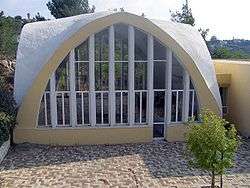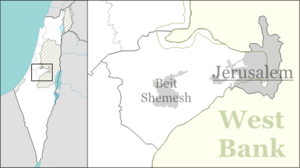Nataf
Nataf (Hebrew: נָטָף, lit. Stacte) is a community settlement in central Israel. Located in the Judean Mountains, 12 miles (19 km) west of Jerusalem, it falls under the jurisdiction of Mateh Yehuda Regional Council. In 2018 it had a population of 449.[1]
Nataf | |
|---|---|
 Village synagogue | |
 Nataf | |
| Coordinates: 31°49′56.28″N 35°4′4.44″E | |
| Country | Israel |
| District | Jerusalem |
| Council | Mateh Yehuda |
| Founded | 1982 |
| Population (2018)[1] | 449 |
| Website | nataf.co |
Etymology
Its biblical name is adopted from the Hebrew word for stacte, one of the spices used in the Temple (Exodus 30:34).[2][3][4]
History
According to Walid Khalidi, Nataf was founded in 1982 on land belonging to the depopulated Palestinian village of Bayt Thul,[5] less than 1 km south of the village site of Nitaf.[6] The village website states that Nataf was built on land bought from Arabs.[4] According to Davar 40 Israeli families bought the land from Abu Ghosh Arabs.[7]
Religious outlook
Only 20% of the residents are Modern Orthodox; 80% of the residents are secular. The village has a unique unaffiliated synagogue with three sections for prayer: a men's section, a women's section and a mixed section.[4]
Geography
Nataf is situated on a ridge bounded by Kefira Valley to the north and Hamisha Valley to the south; the elevation is around 500m above MSL. It lies at the end of a 3-mile road that passes through Abu Ghosh.
Nataf overlooks Nataf Valley, a popular hiking destination. Nataf spring is watered all year round and has a number of small freshwater pools.[4]
Notable residents
- Avram Burg (b. 1955), politician, author and businessman
- Bradley Burston, retired journalist
- Ehud Shapiro (b. 1955), multi-disciplinary scientist, artist and entrepreneur
References
| Wikimedia Commons has media related to Nataf. |
- "Population in the Localities 2018" (XLS). Israel Central Bureau of Statistics. 25 August 2019. Retrieved 26 August 2019.
- Carta's Official Guide to Israel and Complete Gazetteer to all Sites in the Holy Land. (3rd edition 1993) Jerusalem, Carta, p.358, ISBN 965-220-186-3
- Bitan, Hanna: 1948-1998: Fifty Years of 'Hityashvut': Atlas of Names of Settlements in Israel, Jerusalem 1999, Carta, p.47, ISBN 965-220-423-4 (in Hebrew)
- "נטף | אודות נטף". www.nataf.co (in Hebrew). Retrieved 2017-10-24.
- Khalidi, Walid (1992). All That Remains: The Palestinian Villages Occupied and Depopulated by Israel in 1948. Washington D.C.: Institute for Palestine Studies. p. 290. ISBN 0-88728-224-5.
- Khalidi, 1992, p. 307
- "זמיר יהודה למשטרה: למנוע הקמת ישוב בנטף הדרושיפ הצעירים דז". Retrieved 2017-10-25.